(v12.14.14)
Art, Architecture and Design
This article spotlights a particular building or some other aspect of Columbus design. I welcome your comments, corrections and additions. Please share your experience and perceptions of these uniquely Columbus projects.
 Miller House and Garden
Miller House and Garden
- Built: 1957
- Address: Access restricted to official tours only
- Design Architect: Eero Saarinen (Bloomfield Hills, Michigan)
- Interior Designer: Alexander Girard (Santa Fe, New Mexico)
- Landscape Architect: Dan Kiley (Charlotte, Vermont)
- General Contractor: Taylor Brothers Construction (Columbus, Indiana)
- National Historic Landmark (2000)
Miller House and Garden is a classic mid-Century modern (MCM) residence designed by Eero Saarinen for the late industrialist, banker, philanthropist and patron of architecture J. Irwin Miller. Completed in 1957, it was the home of Miller, his wife Xenia and their 5 children. Following Mrs. Millers death in 2008, the residence was donated to the Indianapolis Museum of Art (IMA) who began offering tours of the National Historic Landmark in 2011 in conjunction with the Columbus Indiana Visitors Center. The house can be directly compared to 3 other mid-century modern residential masterpieces which have also been preserved and are open to the public. They are: the Philip Johnson Glass House in New Canaan, Connecticut (1949), Mies van der Rohe’s Farnsworth House in Plano, Illinois (1951) and the Charles Eames House near Los Angeles (1949) – all open to the public at scheduled times. The house bears resemblances to Mies van der Rohe’s 1929 Barcelona pavilion because of the walls in the public areas made of thick slabs of marble with exposed edges and the huge expanses of glass reducing the separation between inside and outside. The cruciform columns eliminate load bearing walls maximizing the flexibility of room arrangements.
Miller had first met and became close friends with Eero Saarinen during the design and construction of the First Christian Church. Saarinen later designed the downtown Columbus banking center for Irwin-Union Bank. There are striking similarities between the glass-walled banking pavilion downtown and what a few years later emerged as the Miller House. Unlike some other notable mid-century modern masterpieces that were never intended or proved impractical for full-time use, the Millers needed a practical home to raise their 5 children. The Millers, especially Xenia, were deeply involved in the design process with Eero Saarinen, landscape architect Dan Kiley and designer Alexander Girard. Saarinen’s spare interior of white marble walls with travertine and terrazzo floors was touched with color, texture and whimsy by Girard’s warm, colorful textiles and international folk art. Landscape architect Dan Kiley created a series of geometric outdoor rooms including an allee of honey locust trees that echo the grid of the house. His garden changes around every side of the house giving unique views from every window. The result was a unique collaboration between clients who knew what they wanted and talented designers who could deliver. The Miller House and Garden (MHG) integrates the structure, the interior design and the landscape into a total work of art.
The Millers purchased the 13.5 acre property in 1953 that had previously been a cornfield. Design and construction lasted 4 years with the family taking residence in 1957. Many people from the Saarinen office were involved in the design but notably Kevin Roche who was the principal design associate. Miller needed a home worthy of entertaining world leaders and corporate heads yet still be a comfortable place for his family. He also wanted the house to not be ostentatious despite the fact that he was probably the richest resident of Columbus. He requested that the house be no larger than the functional needs required by his family but that it be of the highest quality. This was one of the very few private homes designed by Saarinen and epitomizes the classic modernist ideals: an open and flowing floorplan, flat roof and glass and slate walls. The rectangular Miller House is shielded from the surrounding neighborhood by a staggered series of arbor vitae hedges. The house is on the the high point of the property that flows via a meadow to the Flatrock River below. At 6,838 square feet, the more private functions of the house are organized around a large central space. Some have compared it to the geometric arrangement of Andrea Palladio’s 16th century Villa Rotunda. These four outer quadrants of the house are the kitchen/laundry, an area for the guests and servants, a corner for the 5 children and a suite for the parents. One part of the space on the wall between the main entryway and the guest suite is defined as well as an open carport for the vehicles.
Structurally, the entire weight of the roof is supported by 16 free-standing cruciform steel columns which defines the 9-square grid of the floorplan. An intricate continuous skylight system forms a grid pattern throughout the house around the columns. The columns and skylights also extend around the entire perimeter of the house. The roof overhangs the walls covering a terrazzo terrace which completely surrounds the house. Inside the skylight grid system are artificial lighting fixtures to illuminate both the interior and exterior of the house at night. Since none of the walls are load bearing, the rooms and areas do not have to fit strictly within the grids. The skylights are used effectively running over dressing areas for example rather than sleeping areas.
As you enter the rather modest front entrance to the home and pass through a short entry way you are suddenly in the vast central living space. Although the word “great room” was defined years later for the combination living/family/dining room in present day ‘McMansions”, this one truly should have defined the term!
Just adjacent to the dining room is a sitting/mingling area close to the circular fireplace designed by Balthazar Korab. Reportedly this fireplace was his only assignment during the 2 years he spent with the Saarinen office, offering up version upon version until Saarinen was finally satisfied. Korab decided to change career paths at this point from architect to architectural photographer which has gained him much renown. A fabric panel to the left of the fireplace screens the center of the room from the main entrance area. This part of the room was typically where guests would meet and talk prior to dinner. Behind this area is the 50-foot long rosewood and glass storage wall designed by Girard to be used for books, display of art objects and with concealed storage for the television, stereo, bar and other items. The storage wall is along the one largely windowless side of the house separating the social area from the carport and the guest/servant suite. Girard used patterned backgrounds and art objects inter-spaced with the family book collection giving the wall the appearance of a 3-dimensional mural.
Another small part of the room is grouped around the Grand piano. The Miller children all took music lessons and as they grew older would accompany Mr. Miller as he played his violin. Many guests would play the piano as well. An accomplished amateur violinist, Mr. Miller owned both a Stradivarius and a Guarnarius. After he died, both were sold to working musicians as Mr. Miller wanted to ensure that they would continue to be played.
In a small section open to the main social area but in a niche between the guestroom suite and the children’s suite is a small living room. Concealed in the storage wall was their TV and entertainment system. This area opens directly to the outside leading to the swimming pool. The swimming pool was part of the original plan but wasn’t installed until 1963 when the youngest child learned to swim. A special rug in this area designed by Alexander Girard is filled with symbolic graphics relating to the family.
Tucked off in a niche on the other side between the master bedroom area and the kitchen is the surprisingly small dining room which can be closed off with a curtain for food preparation/cleanup or dramatically opened when dinner is served. One of the only interior Saarinen furnishings in the original configuration is the built-in dining table. With a terrazzo base and a round marble top it resembles the pedestal series tables and chairs that Saarinen began marketing through Knoll in 1958. It is lit from below and features a bubbling fountain in the center. Alexander Girard worked for the Herman Miller company so it was not surprising that most of the original furniture was from Herman Miller especially Charles Eames. The original dining room chairs were Eames chairs with Eiffel tower bases but they were replaced by the Saarinen “tulip” chairs within a few years. Seat cushions for the Saarinen pedestal chairs were designed by Girard with Xenia Miller and her bridge club doing the embroidery. It has been said that Saarinen sitting in the conversation pit reinforced his idea that modern chairs were a “slum of legs causing a confusing, unrestful world” as he gazed over at the Eames dining room chairs. He asserted that his pedestal chairs were the solution.
The home is probably most famous for the sunken living room (or “conversation pit”). The area holds a square sectional sofa with a multitude of accent pillows. Most of the pillow fabrics were designed or selected by Alexander Girard or Jack Larsen. The sofa cushions were made in both red and white and would be changed around several times a tear. The tops of the sofa back cushions are nearly flush with the surrounding floor area giving those seated inside a clear view of the whole room as well as through the west-facing windows. Although only extra-special guests are allowed to sit there now, the grown up Miller children talk about doing running back flips into the pit and it was obviously the perfect place for a slumber party as well! Although the Miller children grew up with respect for their surroundings by all accounts the house was a place where the kids were allowed to be kids.
The Miller Garden is considered to be Dan Kiley’s residential masterpiece and one of the most important iconic modernist gardens. The garden is divided into multiple outdoor rooms, reflecting the geometric order of the house and responding to adjacent interior spaces. Its highly structured site plan has a strong emphasis on orthogonal geometry, but without conventional symmetry. Kiley structured the space around the garden in a Mondrian-style asymmetrical pattern. The main entrance drive is flanked by an allée of horse chestnut trees. An orchard of apple trees, planted in 2 grids separated by a row of white oaks is just east of the drive. The landscape’s celebrated feature is an allée of 36 honey locusts defining an axis along the west side of the house. Magnolia trees and European Weeping Beech trees are planted very close to the house on both the east and west sides. He carefully sculpted the earth to make a perfect slope leading to the very flat meadow. From inside the house the gentle slope is invisible appearing to be a drop off. The meadow flows down to the river area which was left in a natural state. Early plans for some development along the riverfront area including a sculpture garden were nixed by the Millers who were well aware of the nature of the floodplain area. Reportedly Saarinen himself had an early plan to locate the house much closer to the river. Luckily the house has never experienced flooding even during the devastating floods of 2008. Water is however routinely seen in the spring as the river rises sometimes coming halfway up the meadow area.
Every item presently in the house was owned by the Miller’s with many other pieces held in storage so it gives visitors a good look into the way they lived their long lives there and raised 5 children in the house. Miller House and Garden is owned and maintained by the Indianapolis Museum of Art with daily tours conducted by volunteers from the Columbus Visitors Center.
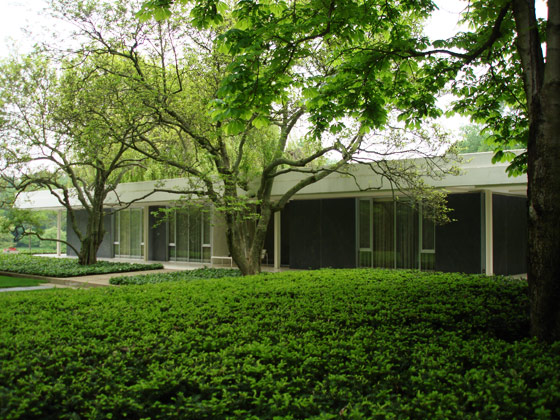 Miller House
Miller House
(photo by khorsean – used pending permission)
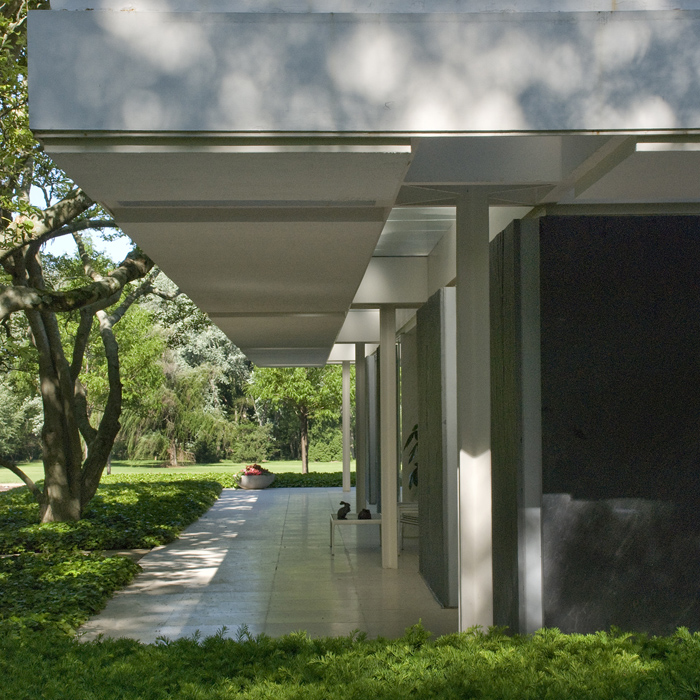 Roof overhangs terrazzo terrace surrounding house
Roof overhangs terrazzo terrace surrounding house
(photo from the IMA – used pending permission)
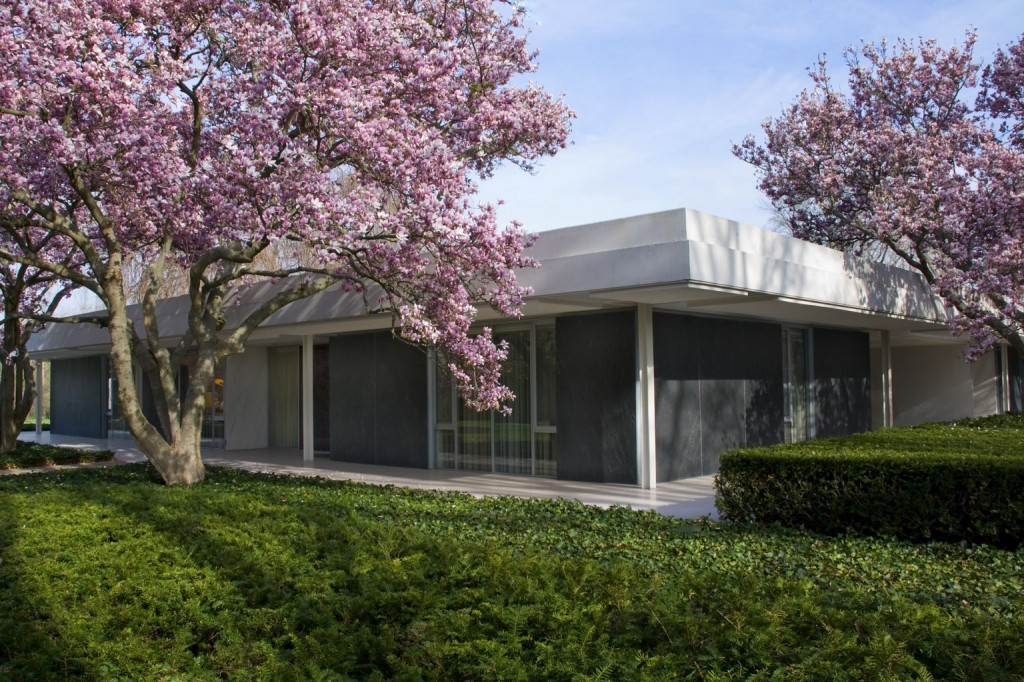 Miller House
Miller House
(photo from the IMA – used pending permission)
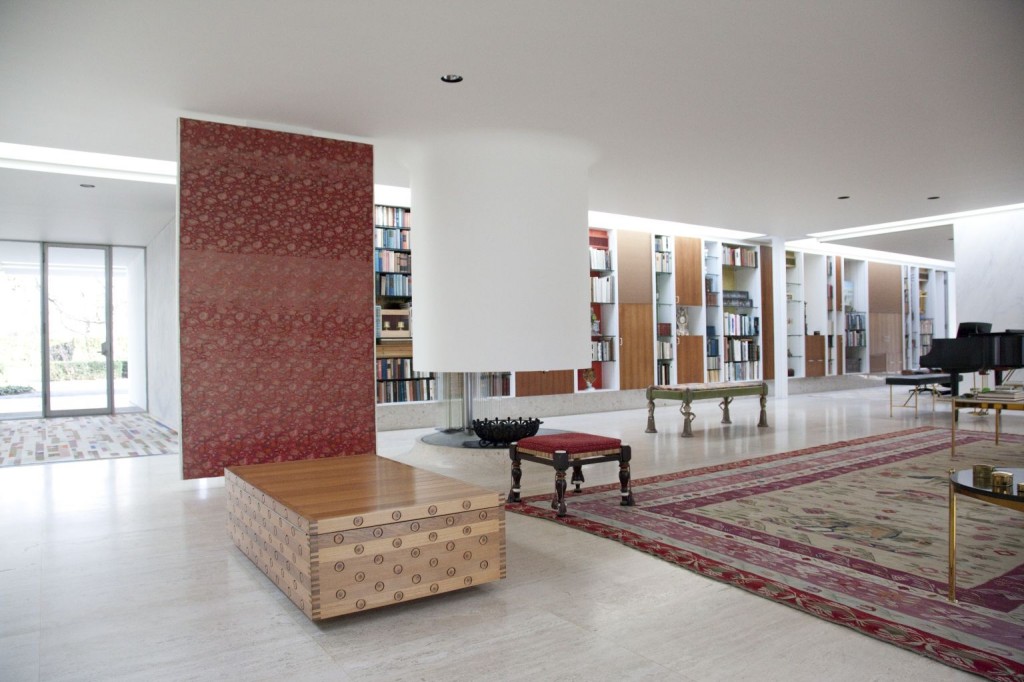 Main entrance on the left, circular fireplace designed by Balthazar Korab, Alexander Girard bookwall behind
Main entrance on the left, circular fireplace designed by Balthazar Korab, Alexander Girard bookwall behind
(photo used pending permission)
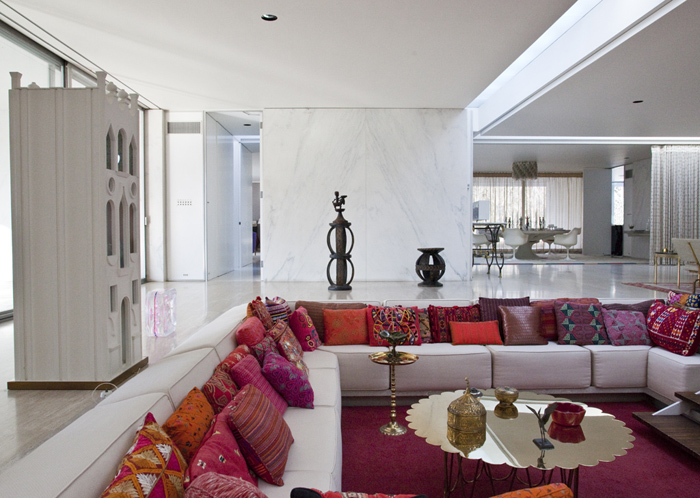 Conversation pit
Conversation pit
(photo from the IMA -used pending permission)
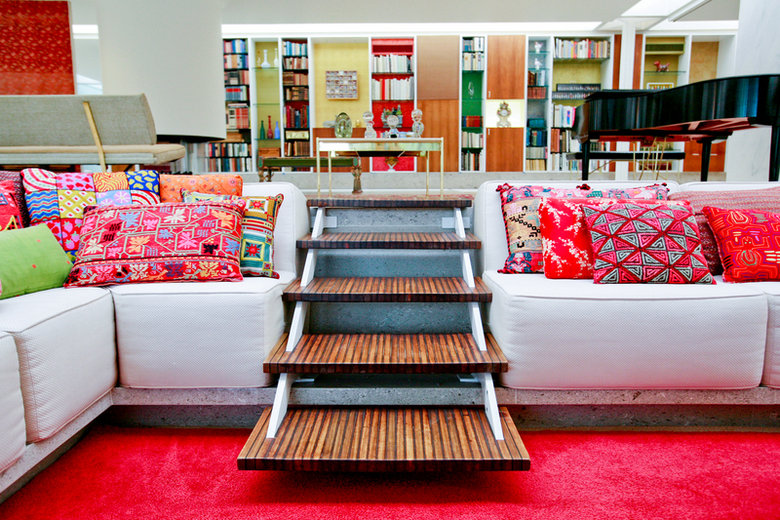 Inside the conversation pit
Inside the conversation pit
(photo by Indianapolis Star – used pending permission)
 Looking into the social area from outside
Looking into the social area from outside
(photo by Ezra Stoller – used pending permission)
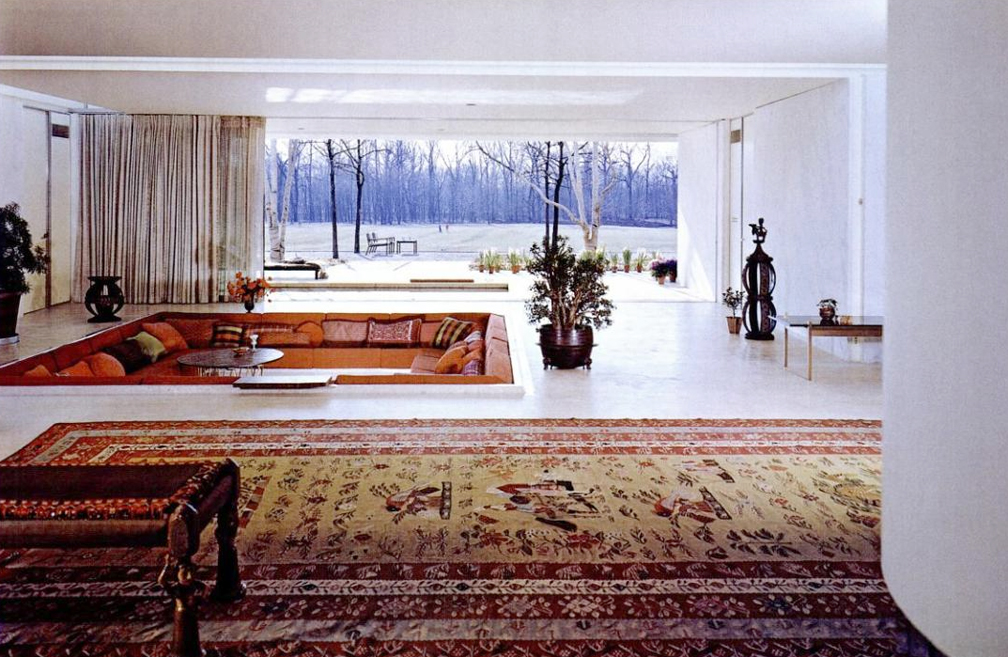 Inside looking out
Inside looking out
(photo by Dwell magazine – used pending permission)
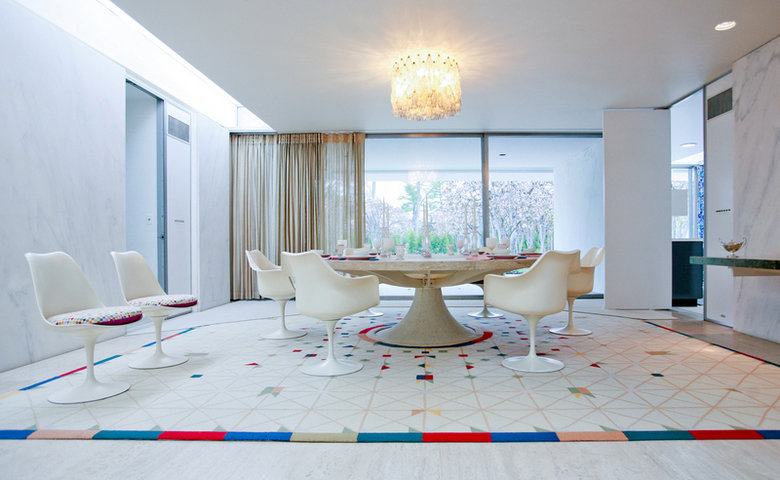 Dining room: table and “tulip” chairs by Saarinen, rug by Girard
Dining room: table and “tulip” chairs by Saarinen, rug by Girard
(photo by Indianapolis Star – used pending permission)
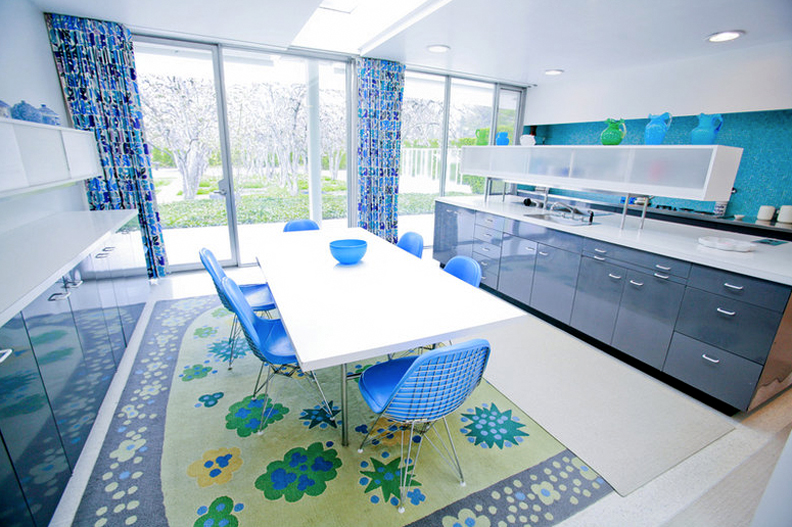 Kitchen: rug and drapes designed by Alexander Girard, chairs by Charles Eames, cabinets from the St. Charles Cabinet Co.
Kitchen: rug and drapes designed by Alexander Girard, chairs by Charles Eames, cabinets from the St. Charles Cabinet Co.
(photo by Indianapolis Star – used pending permission)
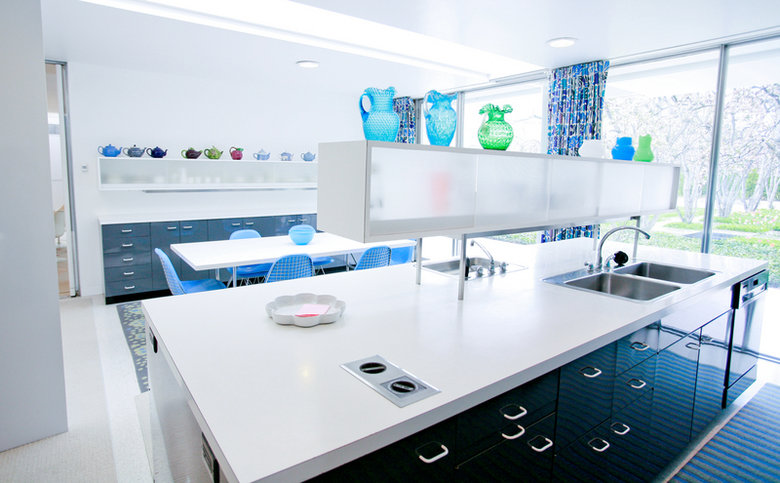 Kitchen
Kitchen
(photo by Indianapolis Star – used pending permission)
 Master bedroom
Master bedroom
(photo by Indianapolis Star – used pending permission)
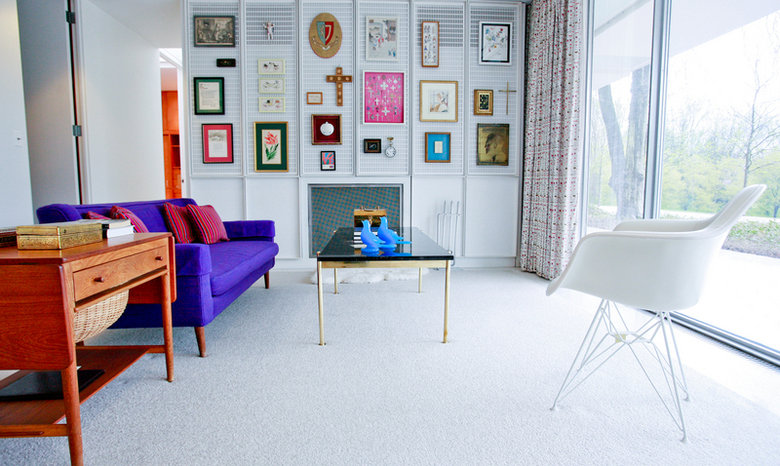
Sitting area in master bedroom
(photo by Indianapolis Star – used pending permission)
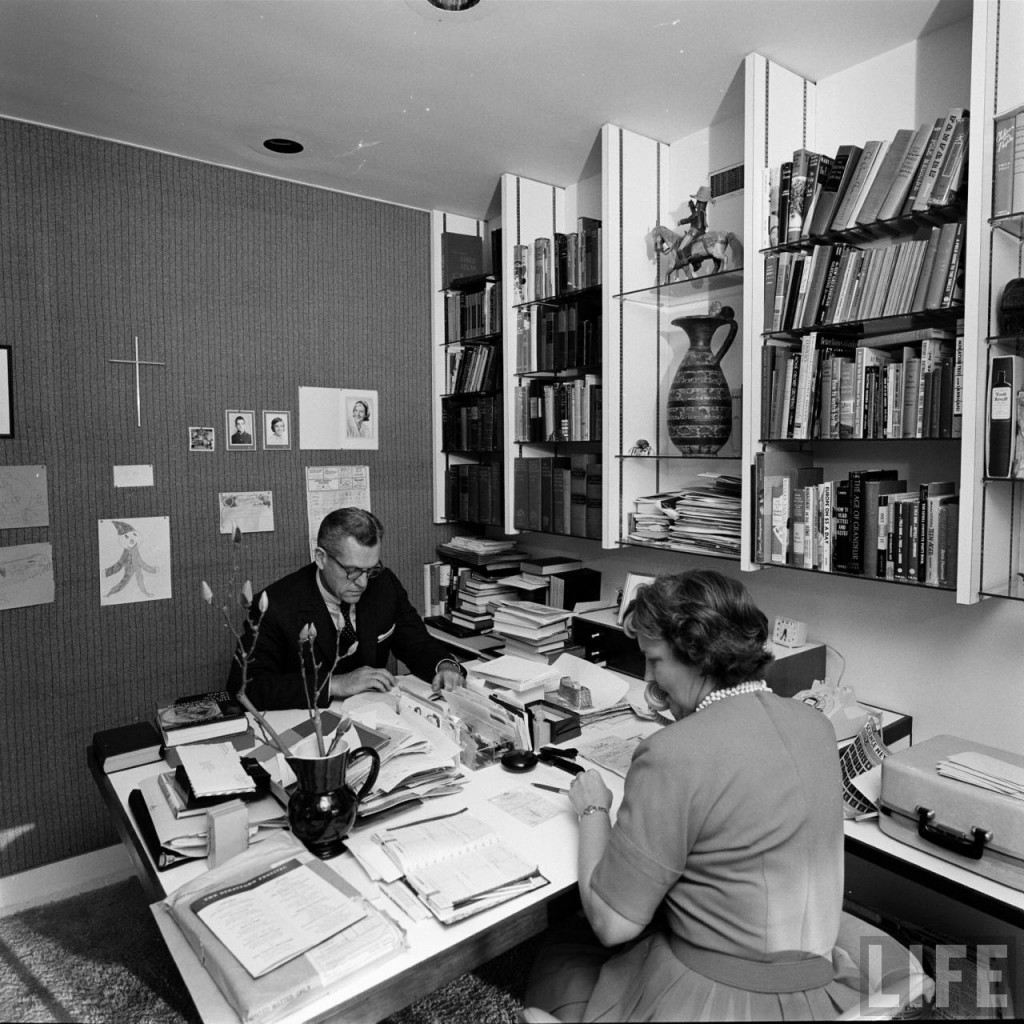 Mr. & Mrs. Miller in the office adjacent to their bedroom
Mr. & Mrs. Miller in the office adjacent to their bedroom
(1961 photo by Frank Scherschel from the Life photo archive – used pending permission)
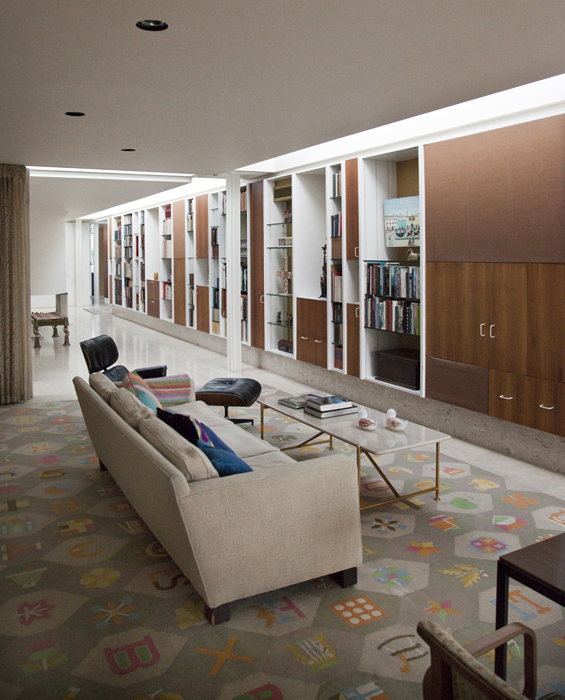 Storage wall: behind it is the carport area and the servant/guest area
Storage wall: behind it is the carport area and the servant/guest area
(photo from the IMA – used pending permission)
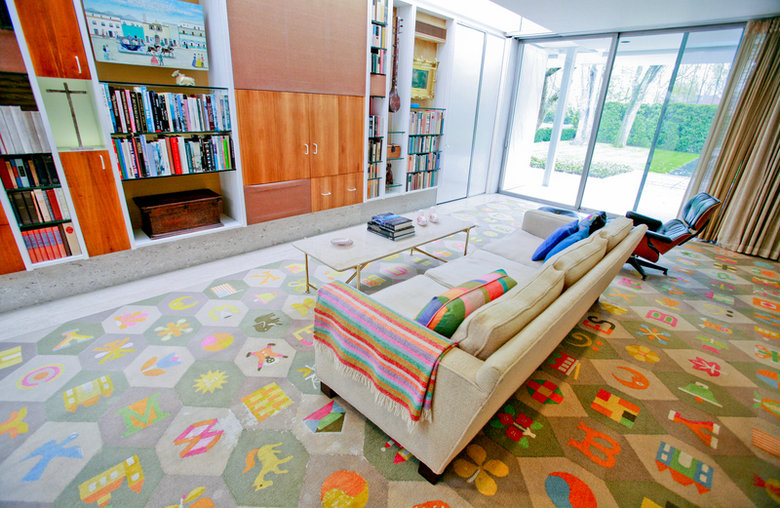 Living room area: Entertainment center hidden in the storage wall, patio door on right leads directly to the swimming pool, rug is designed by Alexander Girard with many symbols relating to the Irwin-Sweeney-Miller family
Living room area: Entertainment center hidden in the storage wall, patio door on right leads directly to the swimming pool, rug is designed by Alexander Girard with many symbols relating to the Irwin-Sweeney-Miller family
(photo by Indianapolis Star – used pending permission)
 Living room rug designed by Alexander Girard: each symbol bears some special relationship to the Miller family
Living room rug designed by Alexander Girard: each symbol bears some special relationship to the Miller family
(photo from IMA – used pending permission)
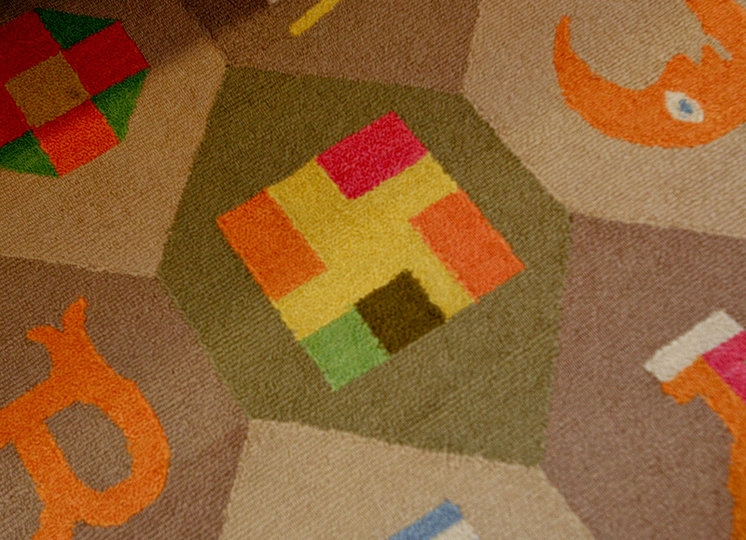 Detail of the Girard rug: symbol represents the layout of the Miller House
Detail of the Girard rug: symbol represents the layout of the Miller House
(photo used pending permission)
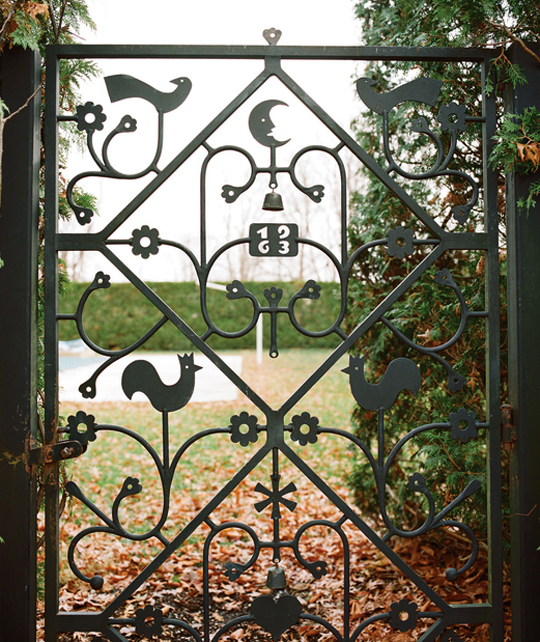 Alexander Girard gate to the swimming pool: at Mrs. Miller’s request the pool was not installed until the children had all learned to swim
Alexander Girard gate to the swimming pool: at Mrs. Miller’s request the pool was not installed until the children had all learned to swim
(photo by Leslie Williamson – used pending permission)
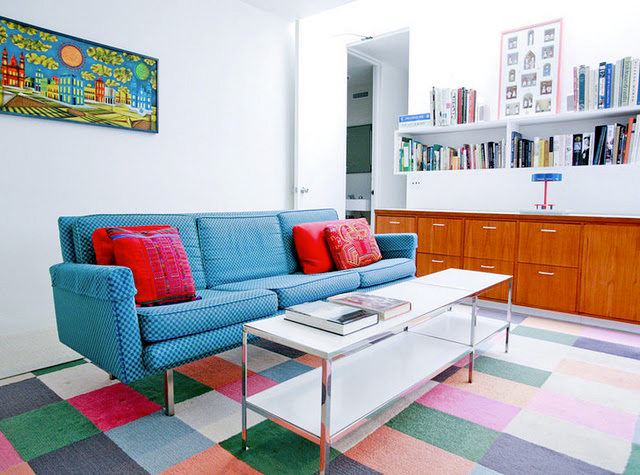 Childrens common playroom/study room – later used as an office by Mrs. Miller
Childrens common playroom/study room – later used as an office by Mrs. Miller
(photo by Indianapolis Star – used pending permission)
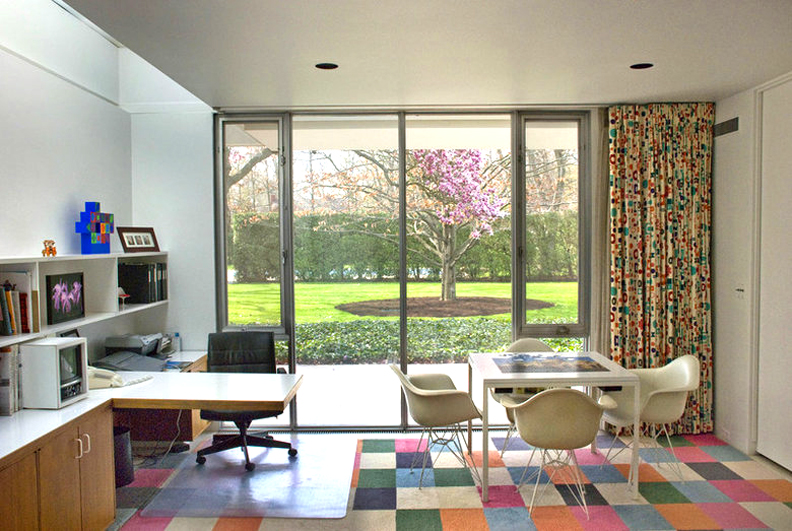 Childrens common playroom/study room – later used as an office by Mrs. Miller
Childrens common playroom/study room – later used as an office by Mrs. Miller
(photo by Indianapolis Star – used pending permission)
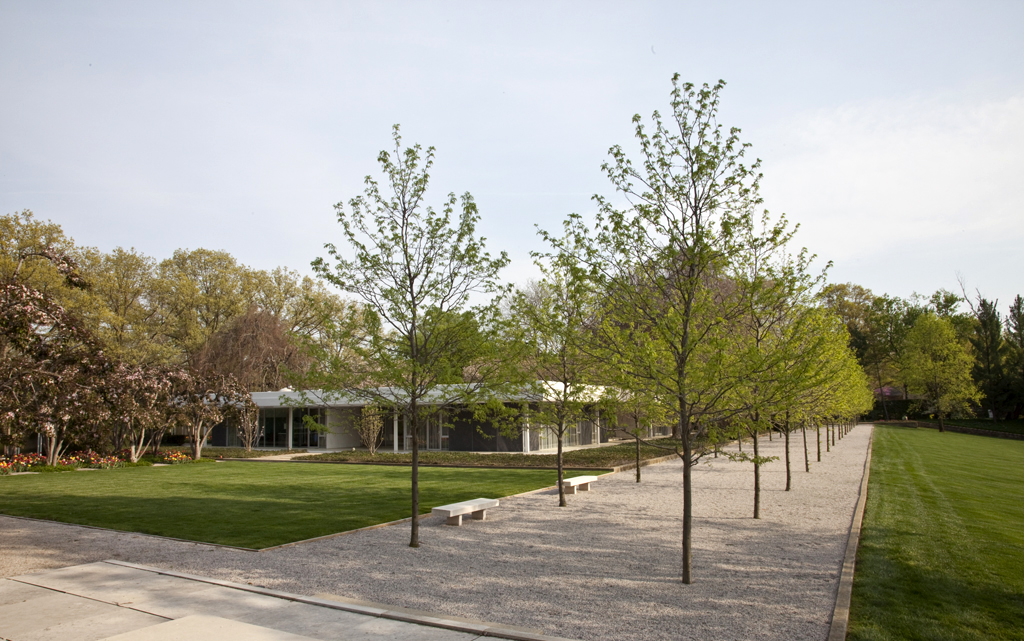 This honey locust allee, a trademark of Dan Kiley, has been replanted numerous times over the years
This honey locust allee, a trademark of Dan Kiley, has been replanted numerous times over the years
(photo used pending permission)
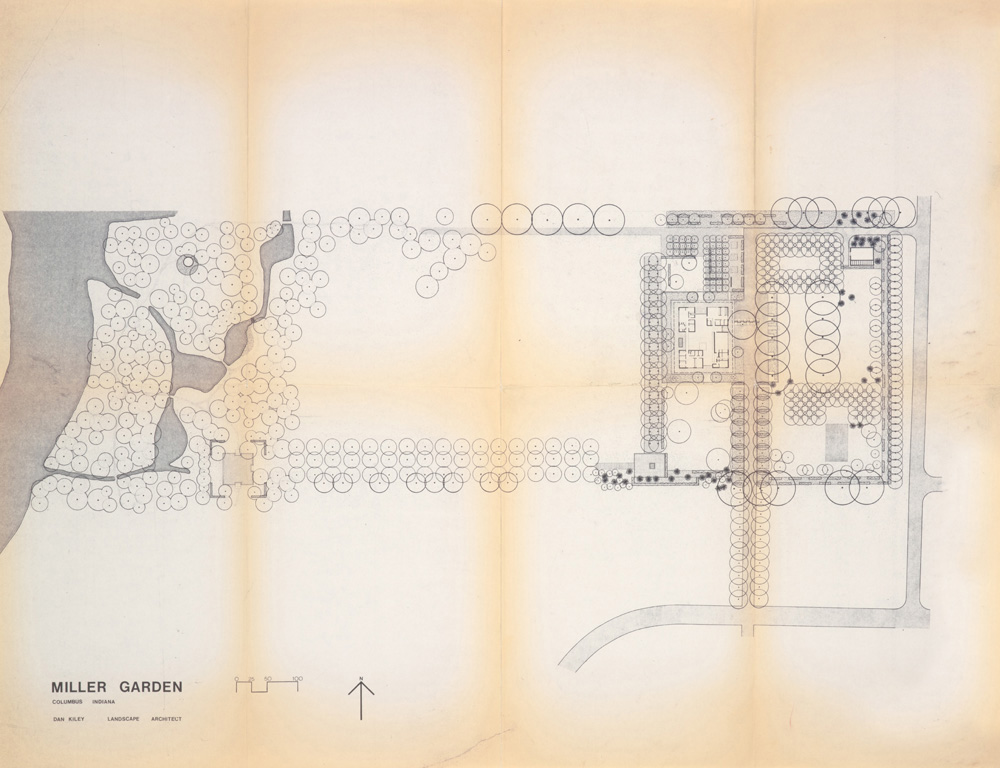 Site plan for house and garden
Site plan for house and garden
(photo from the IMA – used pending permission)
 Layout of the house
Layout of the house
(photo from the IMA – used pending permission)
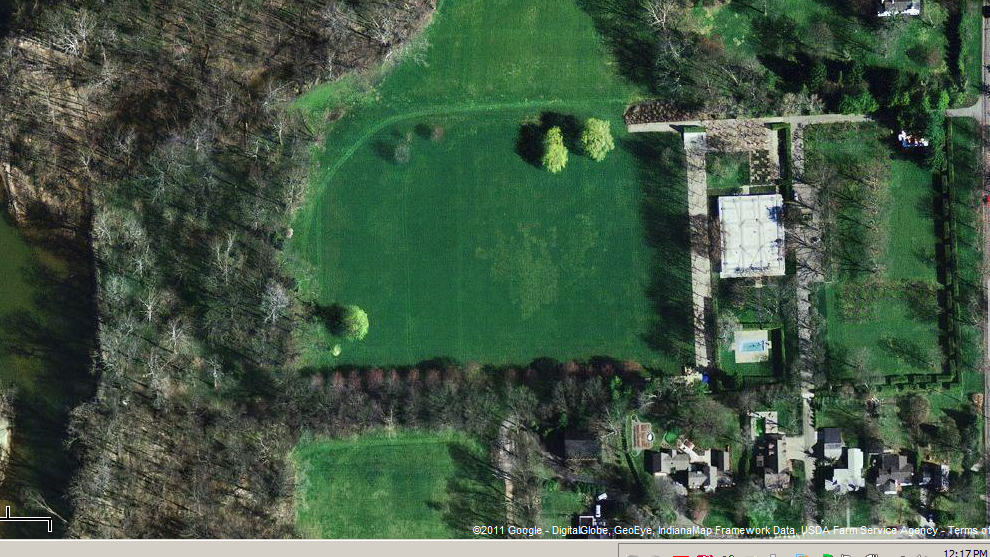 Aerial view of the Miller House and Garden
Aerial view of the Miller House and Garden
(photo from Googlemaps – used pending permission)
The Architects
 Eero Saarinen
Eero Saarinen
- Born in Kirkonummi, Finland on August 21st, 1910
- Died September 1st, 1961
- Cranbrook Academy
- Académie de la Grande Chaumière – Paris (1930)
- Yale University (1934)
- AIA Gold Medal Award
Eero Saarinen was a Finnish-American architect famous for taking modernism to different levels. He is most famous for his simple sweeping and arching sculptural shapes which were amazingly done before the era of computer-aided design and drafting had arrived. Unlike many of his contemporary architects, Eero Saarinen never had a particular defining style but insisted on a unique design to reach the architectural solution for each project.
He moved to the United States from Finland with his family in 1923 when he was 13. His father was Eliel Saarinen who had designed the campus at the Cranbrook Academy in Bloomfield Hills, Michigan as well as becoming the head of the Cranbrook’s Art, Design and Architecture School. Eero became a naturalized United States citizen in 1940. He studied sculpture and furniture design at Cranbrook and then went to Paris to study sculpture at the Académie de la Grande Chaumière in Paris, France. He completed his architectural study at Yale University in 1934 and began working with his father who had an architectural practice based out of his home at Cranbrook besides his academic work there.
He worked with his father from 1936-1950 with a wartime stint working for the Office of Strategic Studies (OSS) from 1942-1945. He gained national prominence on his own when he won the 1948 design competition for the Jefferson National Expansion Memorial (the iconic St Louis Gateway Arch).
After his fathers death, he began his own architectural firm in 1950 as Eero Saarinen & Associates. Besides his many buildings, he also designed interiors and furniture, especially well known for his Womb Chair and the Tulip Chair which were icons of the 50’s and still in production today. He had both studied at Cranbrook and taught there briefly where he had become close friends with Charles Eames who was also an architect as well as a furniture designer known for a number of very iconic chair designs. Eames later became a furniture designer associated with Herman Miller while Eero Saarinen designed furniture for Knoll (Florence Knoll was a graduate of Cranbrook). A number of both Charles Eames and Eero Saarinens furniture designs are still in production today.
Eero Saarinen died while undergoing surgery for a very unexpected brain tumor in 1961: he was only 51 and left behind at least 10 projects that were later completed by the Saarinen firm which was taken over by Kevin Roche and John Dinkeloo. Although his popularity as an architect fell out of favor for a few years there has been a recent surge of interest in his designs and many critics have reassessed his work. Saarinen is now considered one of the masters of American 20th Century architecture. Eero Saarinen’s archive material has been donated to the Yale University Library by Kevin Roche.
Selected Eero Saarinen Projects
1940: Kleinhans Music Hall (with Eliel Saarinen) – Buffalo, New York
1940: Crow Island School (with Eliel Saarinen) – Winnetka, Illinois
1948: Womb Chair
1954: Irwin-Union Bank – Columbus, Indiana
1955: Kresge Auditorium (MIT) – Cambridge, Massachussets
1955: General Motors Technical Center – Warren, Michigan
1956: Tulip Chair (part of the “Pedestal” group which included arm and side chairs and tables)
1957: Miller House – Columbus, Indiana
1958 Concordia College (several buildings) – Fort Wayne, Indiana
1959: Yale Hockey Rink – New Haven, Connecticut
1962: Dulles International Airport – Washington D.C.
1962: Bell Labs – Holmdel, New Jersey
1962: TWA Terminal at JFK Airport – NYC
1964: North Christian Church – Columbus Indiana
1965: Gateway Arch – St Louis, Missouri
1965: CBS Building (“Black Rock”) – NYC
 Alexander Girard
Alexander Girard
- Born in NYC on May 24th, 1907
- Died in Santa Fe, New Mexico in 1993
- Royal School of Architecture – Rome, Italy
Alexander H. Girard (often referred to by his nickname Sandro) was an architect, interior designer and authority on world folk art. Girard is widely considered as the greatest colorist and textile designer of the modernist era. He utilized traditional folk art idioms to infuse color, whimsy, and humor into vibrant contemporary designs. He was born in 1907 in New York City to an American mother from Boston and a French-Italian father. He spent most of his growing years in Florence, Italy.
He was known for his innovative interior furnishings including furniture, fabrics, wallpaper, textiles and graphics. He is remembered for his bold colors, dramatic and abstract patterns and interesting textures. He was head of the textile division of the Herman Miller Company.
During his life he became an authority and serious collector of folk art amassing thousands of pieces from around the world. In 1962, Girard and his wife Susan established the Girard Foundation in Santa Fe to manage their collection of folk art that numbered over 100,000 pieces including toys, dolls, icons, and ethnic expressions. Girard’s design work was heavily influenced by his passion for folk art. In 1978, Girard contributed his folk art collection to the Museum of International Folk Art in Santa Fe, New Mexico which has an international recognition as home to the world’s largest collection of folk art. During the last year of his life, he donated his vast collection of textiles as well as the contents of his design studio to the Vitra Design Museum. He died in 1993 at his home in Santa Fe, New Mexico.
Selected Alexander Girard Design Projects
1951: Rieveschi residence (interior design) – Grosse Pointe, Michigan
1957: Miller House (interior design) – Columbus, Indiana
1960: La Fonda del Sol Restaurant (designs for all phases of the restaurant’s operations) – NYC
1961: Herman Miller Textiles and Objects Showplace (interior design) – NYC
1963: Gregory residence (interior design) – Wayzata, Minnesota
1964: John Deere Headquarters (mural) – East Moline, Illinois
1965: Braniff Airlines (designs for all phases of the airline operations including stewardess uniforms and airplane graphics)
1966: L’Etoile Restaurant in the Sherry Netherlands Hotel (interior design) – NYC
1967: The Compound Restaurant (interior design) – Santa Fe, New Mexico
 Daniel Urban Kiley
Daniel Urban Kiley
- Born September 2nd, 1912 in Boston, Massachusetts
- Died February 21st, 2004 in Charlotte, Vermont
- Harvard School of Design
Dan Kiley was one of the highest acclaimed and prolific landscape architects with over 1,000 designs in his portfolio. He grew up in Boston, Massachusetts and discovered landscape architecture working as a golf course caddy. As a teenager with limited funds he would often take his dates to the Arnold Arboretum which further increased his interest in trees and landscaping.
After graduating from from high school in 1930, Kiley became an apprentice under landscape architect Warren H. Manning. Manning in turn had for years worked with another highly regarded landscape architect Frederick Law Olmsted. Both Manning and Olmstead heavily influenced young Kiley. While with Manning, he attended the Harvard School of design but clashed with what he felt was an old-fashioned curriculum. He left Harvard in 1938 without graduating. While at Harvard, Kiley developed a close bond with fellow classmates James Rose and Garret Eckbo.
Manning died in 1938 and Kiley partnered with architect Louis Kahn in Washington D.C. working for the U.S. Housing Authority designing housing projects. During WWII Kiley started out in the infantry but his design skills led to his working for the Office of Strategic Services (OSS) as their chief of design. In an odd assignment for a landscape architect, he designed the courtroom in Nuremburg, Germany for the Nazi war crimes trials. While in Europe he travelled widely and was especially influenced by the gardens of the Palace of Versailles designed by André Le Nôtre. The control and symmetry that he encountered there inspired much of Kiley’s later work.
After the war, Kiley opened several small offices on his own eventually establishing his practice in Charlotte, Vermont. He lived on a farm in Vermont with his wife, Anne, and their 8 children. He partnered with architect Eero Saarinen on a number of major projects.
Kiley’s designs were often characterized by unique geometric layouts of allees, bosques, water, paths, orchards, and lawns. Kiley believed that geometry was an inherent part of man and it was the structure man could use to gain comprehension and create stabilization of his surroundings. He also firmly believed that man was a part of nature, rather than being separate from it. Rather than copying and trying to imitate the curvilinear forms of nature he asserted mathematical order to the designs he placed in it. He died at his home in Charlotte, Vermont at the age of 91 in 2004.
Selected Dan Kiley Landscape Projects
1947: Landscaping design for the Jefferson National Expansion Memorial (never implemented) – St. Louis, Missouri
1957: Miller House and Garden – Columbus, Indiana
1963: Dulles Airport – Washington, D.C
1964: North Christian Church – Columbus, Indiana
1968: Air Force Academy – Colorado Springs, Colorado
1969: Oakland Museum – Oakland, California
1983: Dallas Museum of Art Sculpture Garden – Dallas, Texas
1985: Fountain Place – Dallas Texas
Historic Columbus
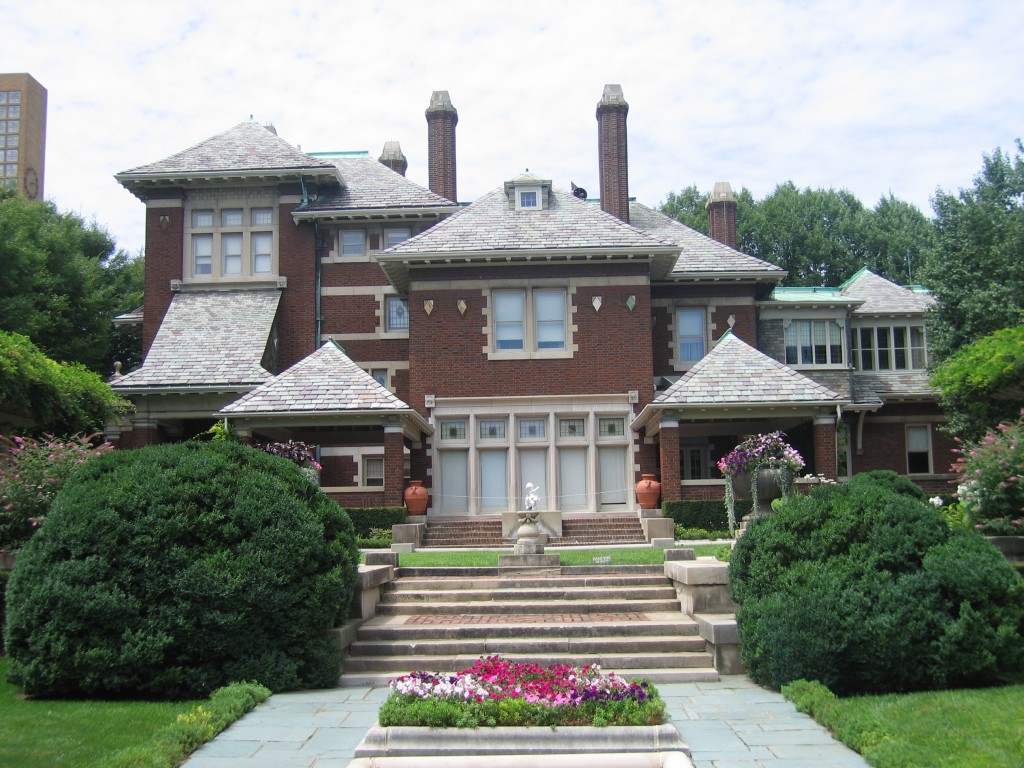 Irwin House and Gardens
Irwin House and Gardens
(photo by Ricky Berkey)
This was the home for multiple generations of the Irwin-Sweeney-Miller family. Built in 1864 and extensively remodeled in 1910, this is the home that J. Irwin Miller grew up in. He continued to maintain it as a family residence even after his sister Clementine Tangeman died who was the last resident. Although the family attempted to find a way to donate the house to a non-profit organization after the death of Xenia Miller in 2008, it was eventually sold and is now being operated as a bed and breakfast. This house is an extremely important piece of Columbus history.
Links/References
Indianapolis Museum of Art (IMA): the IMA owns and maintains the Miller House and Garden
NHL nomination form: Detailed NHL nomination information for the Miller House
Miller House Photo Gallery: from The Republic newspaper
Farnsworth House: MCM residence designed by Mies van der Rohe for Edith Farnsworth
Phillip Johnson Glass House: MCM residence designed by Phillip Johnson for himself
Eames House: MCM private residence designed by and for Charles and Ray Eames
City of Columbus: official City of Columbus website
Columbus Indiana Architectural Archives
Columbus Indiana Architecture Digital Archives: A small portion of the Columbus Indiana Architectural Archives available online from the IUPUI digital library
3D Models of Columbus Architecture Executed in Google SketchUp:
The Republic Newspaper – Columbus, Indiana newspaper
Bartholomew County Public Library
Historic Columbus Website – David Sechrest’s tribute to Columbus History
Historic Columbus Message Board – a companion interactive forum to the David Sechrest historical website
Bartholomew County Historical Society
 Click HERE for a Calendar of Upcoming Events in the Columbus Area.
Click HERE for a Calendar of Upcoming Events in the Columbus Area.
Click HERE for information about Tours of Columbus Architecture and Design including the Miller House.
 Ricky Berkey
Ricky Berkey
Email me: rickyberkey@gmail.com

Pingback: MADE STATELY / INDIANAmade & state